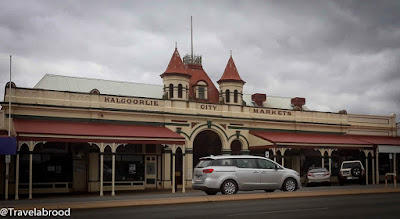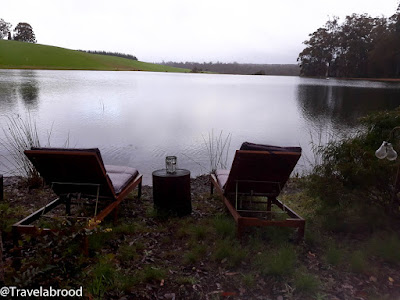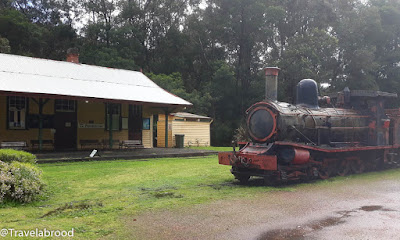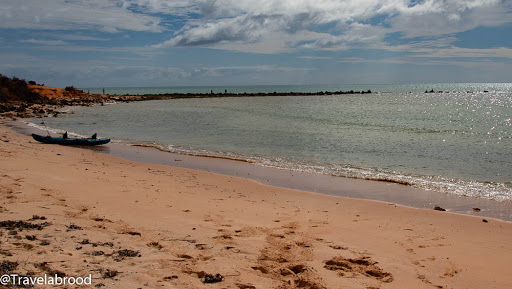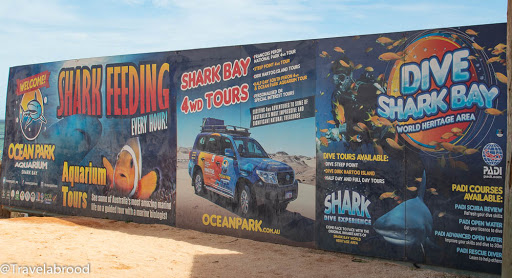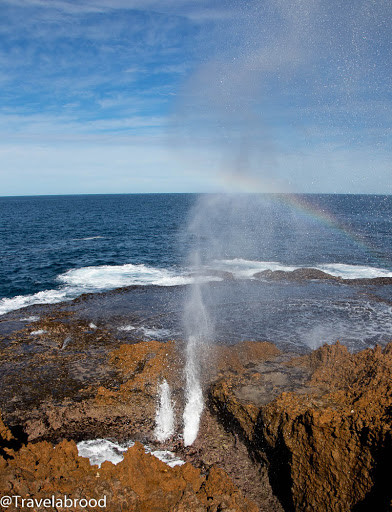OUTBACK ROADIE
WA CORAL COAST
KALBARRI, MONKEY MIA, RED BLUFF
COVID ADVENTURES 2020
Western Australia's
Coral Coast stretches from Cervantes (approximately 2 hours' drive north of Perth) to Exmouth and the world heritage-listed Ningaloo Reef. Having visited Ningaloo on a previous trip, this roadie we decided to visit Kalbarri, Monkey Mia and only go as far north as Red Bluff located on Quobba Station.
We were a brood of four adults taking a ten-day break from work commitments, so we were happy to camp, but didn't really want to rough it too much. With that in mind, each couple rented a 4WD
Apollo Adventure Camper. The converted manual drive Toyota Hilux is made for two and comes complete with bedding, gas cooker, kitchen utensils and camp table and chairs as part of the rental. We collected and returned our vans from the Perth depot located near Perth Domestic Airport and headed north on the Brand Highway.
First stop was Port Gregory and the
pink lake of Hutt Lagoon. The pink lake lookout is about 15km off the main road to Kalbarri, however the detour is well worth it. Unfortunately, the rain started just as we arrived, however the lake was full and the stunning pink caused by the carotenoid-producing algae was an amazing contrast against the grey of the clouds.
There are public toilets located at the Port Gregory Jetty carpark.


We reached Kalbarri around 5.00pm after travelling nearly 600km and stayed at
Murchison House Station. Located on the banks of the Murchison River, the working station offers bush camping (4WD access only) or camping at the homestead (2WD accessible) where there is a camp kitchen and toilet/shower facilities. Campfires are permitted in the winter months and wood is either BYO (bring your own) or can be purchased from reception.
The Kalbarri region offers a heap of family orientated activities. Walks along the 400 million year old
Kalbarri Coastal Cliffs include the Bigurda Trail, an 8km walk from Natural Bridge to Eagle Gorge, the 3km nature trail loop at Mushroom Rock and snorkelling at Blue Holes.
The
Kalbarri National Park is located along the Kalbarri-Ajana Road. Park entry fees apply and can be paid on arrival. Alternatively, parks passes can be pre-purchased
online.
Tip: If you are an
RAC member, it works out cheaper to purchase an annual parks pass which allows up to two vehicle registrations.
The spectacular
Kalbarri Skywalk (Kaju Yatka) which was officially opened in June 2020 allows visitors to walk 100 metres above Murchison Gorge. The twin structures are wheelchair accessible and there is a cafe and public facilities. If you don't get to visit the other amazing sites within the National Park, the skywalk is great place to stop and enjoy the sandstone cliffs, gorge and wildflowers.
Other attractions and walks within the park include: Meanarra Hill Lookout, Natures Window, Z-Bend Lookout, Hawks Head and Ross Graham Lookout. The Z-Bend River Trail is a 2.6km return trail which allows access to the river. It is advised to wear appropriate shoes as the walk is quite demanding, steep and includes ladder climbs.
Approximately 3 hours north of Kalbarri are the
Hamelin Pool Stromatolites. Stromatolites are regarded as living fossils. 80% of the history of all life was stromatolites and the ones found at Hamelin Pool date back 3.5 billion years.
The 1.4km Boolagoorda Walk links the Old Telegraph Station (built in 1884) and the Old Conquina Quarry with the Stromatolites.
Shell Beach is a 70km organism graveyard of snow-white beach made up of millions of tiny Conquina or cockle shells. The very salty water makes it easy to float.
The Shark Bay World Heritage Area is 2.2 million hectares of natural beauty. A diversity of peninsulas, islands and bays, it is a meeting point of tropical, desert and temperate climes, therefore animals and plants have adapted to live in all three climatic zones. There are coastal campsites available, however permits and rules apply. We camped at the Eagle Bluff campground along the Eagle Bluff Boardwalk road.
Denham is an old Pearling town and the town cemetery located on the right on the way into the coastal town is worth a visit. A number of buildings in Denham are made from blocks cut from the compacted
Coquina (shell). The 2.3km
Denham Discovery Trail will take you past sites of interest in the town, whilst the 5km walk from Nicholson Point to Little Lagoon meanders across shrub lands and offers a large range of plant species and bird life.
Francois Peron National Park is where the desert meets the ocean. The road access is via the Peron Homestead and is only available to high clearance 4WDs. There is a complimentary tyre compressor at the entrance to the park. Camping and park entry fees apply.
The 70km drive from Peron Homestead to Skipjack Point (the furthermost point of the National Park) takes around 1.5 hours. Big Lagoon, South Gregories, Gregories, Bottle Bay and Herald Bight allow camping.
Peron Homestead was once a working pastoral station in the early 1900s. The self-guided tour of the historical attraction takes around 30 minutes visiting the shearing shed, stockyards and museum.
The
Ocean Park Aquarium is an award-winning, eco-friendly aquarium located within the Shark Bay Marine Park. Tours are available and there is a restaurant with spectacular ocean views.
Wooramel River Retreat offers accommodation, riverside camping and artesian bore baths. Located just off the highway at Wooramel, it is a welcoming overnight stop. Campfires are permitted (BYO wood) and communal campfire dinners are available on Monday and Wednesday evenings (check website for details).
Carnarvon is known as Western Australia's fruit bowl. Located on the Gascoyne River delta, the fertile plantations and farms supply the majority of Perth's fruit and vegetables. The
Carnarvon Fruit Loop Drive Trail is a 10km round trip which visits roadside plantations and the marina where you can buy fresh fish, oysters and prawns. We opted for a picnic at the Carnarvon Facine followed by an ice-cream at
Bumbak's Plantation.
One Mile Jetty is located just 3km from Carnarvon town centre. Unfortunately, the jetty was closed when we visited, however
Sunsets Cafe was open.
Carnarvon played a role in the manned space program and in the Australian communications industry. The station was commissioned in 1964 to support NASA's Gemini, Apollo and Skylab programs. Today, the
Space and Technology Museum celebrates this little known history and is an interesting place to tour when visiting Carnarvon.
Quobba Homestead is only an hours drive from Carnarvon, however Red Bluff (at the northern end of Quobba Station) is around 60kms further north on an unsealed, ungraded road. Although it is 2WD accessible, we passed a couple of 2WD cars struggling with the road. The
Red Bluff Campsite overlooks one of
WA's best surf beaches and offers campsites, ensuite retreats, bungalows with a shared camp kitchen, beach shacks and unpowered camp sites. There is a shop which sells basic supplies.
The
Quobba Blowholes are located at the station turnoff at Point Quobba. Reaching a height of up to 20 metres high, they are best seen on an incoming tide.
Just one kilometre south of the Blowholes is the Point Quobba Lagoon or "The Aquarium". A fantastic place to snorkel, the lagoon is sheltered from the ocean swell and is home to fish, anemone and coral. It was definitely some of the best snorkelling we have ever done.
It was hard to say goodbye to Red Bluff, the three days of warm weather, wearing shorts and watching the migration of whales from our bungalows. However, we packed up and returned to Perth stopping for our last night at
Oakabella Homestead just south of Northampton.
Founded in 1850, the homestead is surrounded by fields of blooming canola and paddocks of sheep. The tea rooms serve delicious scones and campfires are permitted (BYO wood). There is a camp kitchen, toilet/shower facilities and you can visit the original camp kitchen, shearing shed and buildings. Be warned that the homestead goat makes funny noises at very odd hours and according to the welcome sign ghosts are complimentary.
We had a fabulous trip up the Coral Coast. The vans were excellent and catered to all our needs. The station stays were all very good and apart from the road we really enjoyed our stay at Red Bluff, Quobba Station. The highlights were definitely Big Lagoon in the Francois Peron National Park and snorkelling at the Aquarium at Point Quobba.
Side note: In Carnarvon we purchased some
Black Sapote (aka chocolate pudding fruit). Green on the outside, when cut it is chocolate coloured on the inside and has the consistency of chocolate mousse. Never having had it before, we tucked into it after dinner one eve and really loved the texture. The following night I fancied it up by stewing pears in a little white wine in the microwave, adding a half a dozen marshmallows, peeling the black sapote and discarding the seeds I then layered it onto of the pears, poked half a block of Lindt chocolate into it and put it back in the microwave for 5 minutes. Served with warm custard, it was a sure campfire winner and the bowl was licked clean!
My only other culinary creation was campfire toasted marshmallows between two dark chocolate digestive biscuits (chocolate on the inside). OMG!











